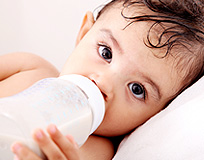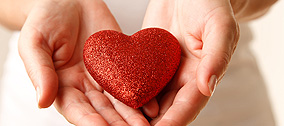Why it's needed
Dietary iron
There are only two kinds of iron that we can use; heme iron from meat, poultry or fish and non-heme iron from vegetables, dairy products or chemically bonded iron in the usual supplements.
Heme iron normally only forms a part of daily dietary intake, but is more readily absorbed than non-heme iron. Unlike non-heme iron, absorption is not affected by other chelating components of the diet such as phytates, tannates and phosphate.
The average amount of dietary ingested iron is 12 - 18 mg daily. In healthy individuals the average iron demand is 1 mg daily for men, 1.5 - 2.5 mg daily for women and during pregnancy 2-3 mg daily corresponding to a total of 500 - 1 000 mg. Iron requirements should compensate for demand during growth, pregnancy and physiological and pathological losses.
In normal health iron management in the body is conservative with little or no loss of body iron save 1-2 mg being excreted, principally by sloughing of cells from the gastrointestinal tract and skin, and menstruation.
Why do we need iron?
Iron is an important part of the red blood cells that transport oxygen to all parts of the body. It can not be substituted with anything else. Iron is the fourth most common element in the earth crust and thought to be the main content of the earth core. Iron is also fundamental for life. Every adult human carries about 3,5 – 4 g of iron, yet this small amount of of mineral, relative to the body weight, is essential being a key building block in several proteins, distributed to three main compartments of the body.÷ The main compartment of iron in the adult human (30 mg/kg body weight) is in the circulating blood, where each mature erythrocyte carries four heme proteins with one Fe ++ atom each. The oxygen carrying heme proteins are also represented in myoglobin, the protein responsible for oxygen storage and transport in muscles (4 mg Fe/kg).
A smaller but yet as important fraction of the body iron (2 mg Fe/kg) is present in various tissues as iron containing enzymes and other proteins. The complete list of functional iron - proteins is not yet understood, but iron is essential in electron transport proteins present in all body cells i.e cytocromes, activators of molecular oxygen (i.e peroxydases and catalases) and many others.
The third compartment of iron is the storage iron, making the body prepared for unexpected loss or changes of iron absorption. This is a " buffer" compartment where large changes can occur between a state of iron depletion (1-2 mg/kg) and repletion without affecting the functional iron compartments. The main storage proteins are ferritin and hemosiderin.
What happens when iron levels are low?
You may get tired, have concentration problems, get bad hair and nails and feel generally weak. Low iron count has also been shown to have a negative impact on learning ability as well as physical ability. Iron status of the pregnant and those who plan pregnancy determines the weight of the foetus. Even to such a degree that it affects the health status of a person during the whole lifetime. More than 30 % of all fertile women suffer from low iron counts due to menstrual loss of blood. Low iron counts increase the uptake of harmful cadmium, which is stored in the skeleton and causes an increasing risk for osteoporosis.
Why is this so common?
Nowadays we eat smaller amounts of iron-rich meat courses than our voracious and hard-working ancestors. We also have a different beauty concept today with a thin body as the ideal and thus less energy-and mineral-rich food is consumed.
Supplementation
The process of building up adequate iron stores takes months, much in the same way that depletion doesn´t happen overnight.This is why supplementary dosage usually is enough. If the dosage is higher than 50 mgs per day zincabsorption will be blocked.
The success of any iron therapy is closely related to user friendliness. This means that tolerance and dosage-related compliance is of central importance.
Who needs it?
Women, who menstruate for four days or more almost always need a supplement of iron to compensate for the blood loss. Other risk groups are athletes, growing youngsters, the pregnant, lactating and the elderly due to either poor diet or high losses or both. Grown men rarely suffer from iron deficiency.
What is heme iron?
Pure hemolyzed hemoglobin powder derivated from the food industry as raw material for iron substitution has been of interest in Sweden since the early seventies, as this is by far the best-tolerated and efficient form of iron.
Over the years the raw material has been developed and used in a number of products.
There are two pathways for dietary iron. Heme iron, which is found in all meat products, is absorbed efficently and neatly as a whole unit. The other kind is simply non-heme iron and has to be broken down in the gut before the ironcan be absorbed. Most of the free iron remains in the gut and causes side-effects such as constipation, diarrhea and stomach cramps. The uptake of non-heme iron is also affected by other foods consumed. Tea, coffee, milk andeggs, for instance will ruin the absorption, but vitamin C in orange juice will help absorption of non-heme iron.
More Info
-
 Chronic diseasesChronic diseases
Chronic diseasesChronic diseases -
 Blood DonationBlood Donation
Blood DonationBlood Donation -
 Mother and BabyMother and Baby
Mother and BabyMother and Baby -
 Iron AbsoptionIron Absoption
Iron AbsoptionIron Absoption -
 Iron DeficiencyIron Deficiency
Iron DeficiencyIron Deficiency -
 Fertile FemalesFertile Females
Fertile FemalesFertile Females -
 Health / PregnancyHealth / Pregnancy
Health / PregnancyHealth / Pregnancy -
 Studies and TextsStudies and Texts
Studies and TextsStudies and Texts -
 OptiFer® Heme iron productsOptiFer® Heme iron products
OptiFer® Heme iron productsOptiFer® Heme iron products
About the Latest Action
 The OptiFer® Series of original Heme-Iron products are made in Sweden under full HACCP quality standards.
The OptiFer® Series of original Heme-Iron products are made in Sweden under full HACCP quality standards.
WHAT THE DOCTORS HAVE TO SAY
I have a number of patients that have taken heme iron preparations for years. They have kept a satisfactory iron balance without the unfortunately all-too-common side effects that are often associated with iron preparations.
Dietary-based treatment containing heme iron has few side effects and can be used efficiently to improve the iron status of women of reproductive age.
